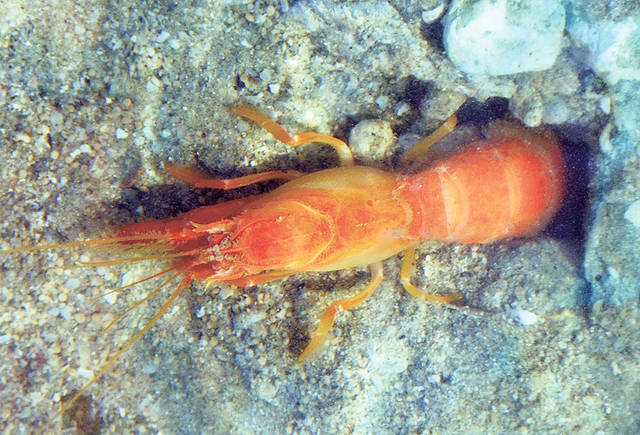Published in the Ocean Watch column, Honolulu Star-Advertiser © Susan Scott
May 27, 2017
BRAMPTON ISLAND, GREAT BARRIER REEF MARINE PARK >> For the past few days, I’ve been choosing walking over snorkeling. That might seem a poor choice given where we’re sailing. This week, however, the new moon has brought spring tides, and here off the Queensland town of Mackay, that means a 15-foot difference between the high and low. So when the tide is out, the reefs are, too.
 A shrimp at low tide off Australia’s Great Barrier Reef Marine Park
A shrimp at low tide off Australia’s Great Barrier Reef Marine Park
waits for a spring tide to return and carry it away.
©2017 Susan Scott
Spring tides have nothing to do with springtime. The name comes from a centuries-old notion that during new and full moons, the water “springs” up. Here where we’ve anchored Honu, the incoming tide seemed to leap rather than spring, covering the places we walked yesterday afternoon with 15 feet of water. We must wait until this afternoon, when the tide drops to its new-moon low, to stroll with the seabirds on the exposed reef.
It sounds awful to be walking on a reef, but we aren’t. We step in sand lanes that the currents have deposited between coral heads, seaweed tufts and rocky spires. In the late afternoon sun, the smooth, water-carved sand whorls remind me of paintings by Georgia O’Keefe.
Puddles and pools remain in the lowest reef flat depressions, where fish, crabs, shrimp, snails, sea cucumbers and countless other creatures lie motionless, waiting for the tide to turn. Those left high and dry, such as giant clams, anemones and coral polyps, close up tight during their dry time.
Because spring tides occur twice a month, the animals clearly have their ways of surviving in air for hours at a time. Even so, given all the damage we humans have done to animals and their habitats, I like to offer a helping hand to my friends.
During our reef walks Craig waits patiently while I carry starfish from dry sand to water-filled depressions left by awesomely huge stingrays. We saw one of these crater makers from the dinghy on our way to the beach and judged it to be about 4 feet wide.
Craig helps with photos too, reducing ripples on the water’s surface by standing heel to heel upwind of a stunning red-orange shrimp in about 3 inches of water.
In spite of four monster feet near its burrow, the shrimp remained motionless for the photo shoot. With its brilliant colors, it seems that hiding would be a better survival strategy than holding still. Then again, movement might give away the shrimp’s position to the stone curlews, oyster catchers, sea eagles and gulls scouting the flats for food.
When sailing among the hundreds of islands in the Great Barrier Reef Marine Park, there are no activities I would choose over snorkeling or diving. Except during spring tides. Then, with pleasure, I choose walking.